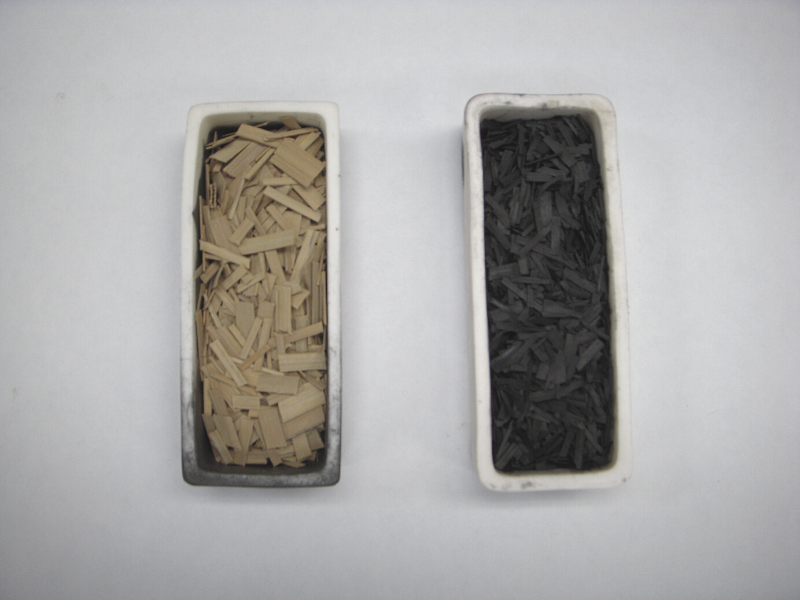Farmers must cultivate a large number of crops to feed the world’s expanding population. Water is necessary for crops to grow and thrive, and 70% of the freshwater consumed globally is utilized to irrigate crops. Water shortages, however, are a problem in many parts of the world.
 A sample of date palm leaf (left) and biochar (right) used in this study. The study took place in California and date palms are grown across southern California for agricultural use. Image Credit: Michael Schmidt
A sample of date palm leaf (left) and biochar (right) used in this study. The study took place in California and date palms are grown across southern California for agricultural use. Image Credit: Michael Schmidt
Yet, water shortages remain a problem in many parts of the world. Alternative water sources that can sustainably supply current and future irrigation demands are being researched.
Crops could be watered with treated municipal wastewater. However, there are various obstacles to overcome. For instance, municipal wastewater could include antibiotics.
These antibiotics could foster antibiotic-resistant bacteria in wastewater-irrigated agricultural systems.”
Michael Schmidt, Researcher, US Salinity Laboratory
The US Salinity Laboratory is part of USDA’s Agricultural Research Service (ARS).
Schmidt is the lead author of a recent study that demonstrated how antibiotics can be removed from municipal wastewater using local plant material or food waste. The scientists utilized biochar, a substance like charcoal produced by burning organic materials at high temperatures without adding oxygen. By adsorption, biochar eliminated more than 97% of the three antibiotics the researchers examined from municipal wastewater.
The ASA-CSSA-SSSA annual meeting was held in Baltimore, Maryland in 2022, and Schmidt presented his study there.
Schmidt added, “We demonstrated that local agricultural byproducts could help remove antibiotics from treated wastewater streams. This represents a potentially cost-effective and environmentally friendly strategy to remove a range of contaminants from wastewater.”
Significantly, Schmidt and colleagues produced biochar using locally accessible plant materials like date palm leaves and pistachio shells. Long-distance transportation is not necessary for local resources. This can cut down on expenses, resource use, and pollution.
The study was carried out in California, a state that produced more than one billion pounds of pistachios in 2020. The Coachella Valley in Southern California is the only place where agricultural production is concentrated, despite being the most significant location in the country for the production of dates. As municipal trees, they are also raised throughout the American Southwest.
“Each date palm tree can produce up to 40 lbs. of dried fronds each year. So, these seemed like a good potential source of biochar,” Schmidt stated.
The researchers also demonstrated that biochar’s ability to remove antibiotics from wastewater depended far more on how it was created than what it was derived from. Biochar is a porous, carbon-rich material that resembles charcoal.
Schmidt further pointed out, “The key to biochar production is the lack of oxygen during heating.”
The predominant byproduct of heating with oxygen is ash, not biochar.
By heating plant materials to 400, 600, and 800 °C (about 750, 1100, and 1470 °F), Schmidt and colleagues produced biochar. The effectiveness of removing three different antibiotics from wastewater was then evaluated using biochar at various temperatures.
The three antibiotics that were the subject of this investigation were trimethoprim, sulfamethoxazole, and sulfapyridine.
They were chosen because they were present in the locally collected and treated wastewater. It was discovered that biochar produced at an oven temperature of 800 °C was the most effective in removing antibiotics.
“We demonstrated that biochar production conditions play a large role in antibiotic removal. This could be helpful to scientists using other materials to produce biochar for this purpose as well,” Schmidt further stated.
Antibiotics are removed from wastewater by biochar via several different chemical processes. The physical features of biochar can affect how effective these chemical mechanisms are. According to the study, time and money could be saved by assessing these physical features of biochar.
Schmidt noted, “Experiments measuring trace levels of antibiotics require costly instruments. We showed that biochar behavior can potentially be interpreted through easily measured properties.”
This could make future efforts to improve charcoal adsorbents for contaminant removal from wastewater more efficient.
Schmidt and colleagues are examining ways to develop biochar-based water treatment systems.
Schmidt concluded, “Future research will incorporate these biochar materials and others into scaled-up water treatment systems. The goal is for these treatment systems to be capable of treating quantities of water that are relevant for field-scale irrigation.”